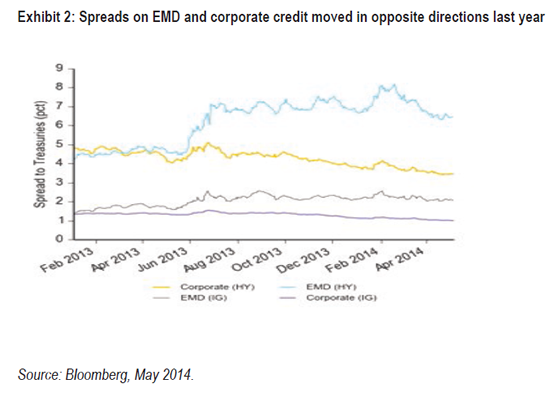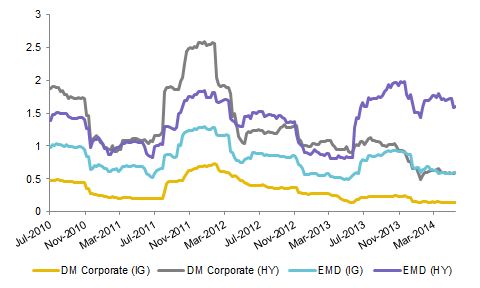Emerging Market Debt From Tactical To Core
Post on: 14 Июнь, 2015 No Comment

From Tactical To Core: The Case For Emerging Market Debt by Columbia Management
A dominant theme over the past few years has been the search for yield, particularly when accompanied by low volatility. Given the meager return on cash, investors have been moving into credit in search of additional returns and into asset classes with perceived levels of low volatility. Corporate credit spreads have tightened steadily, in part due to this demand, resulting in a steady return profile for the asset class. The stresses in the corporate credit markets that were readily apparent during and immediately after the financial crisis have all but disappeared. However, investors now need to look beyond corporate credit for incremental yield, and we believe that emerging market debt (EMD) offers an attractive, high-quality alternative.
Emerging market debt is largely investment grade
Hard currency emerging market debt, i.e. bonds issued in U.S. dollars, is effectively a credit asset class, and spreads (the yield premium) over U.S. Treasury bond yields can be more directly compared to corporate credit spreads. In fact, on a risk spectrum from 1–10, with 1 being Treasuries and 10 being full-beta high yield, emerging market bonds are around a 7.
Emerging market debt has effectively transitioned from a speculative asset class to one in which more than 70% of emerging market debt (using a common emerging market debt index) is now rated investment grade (Exhibit 1). In our view, this progression in credit quality warrants a shift in portfolio allocation away from using emerging market debt as a short-term tactical investment, toward a long-term core-portfolio holding.
Many investors had been increasing their emerging market debt holdings, recognizing their fairly low allocations to emerging market debt relative to the sector’s capitalization and economic importance. However, investor confidence in the sector and its attractive risk-return proposition was unexpectedly tested last year. Yields on emerging market debt and corporate credit, which historically have traded in tandem, moved in opposite directions (Exhibit 2). Spreads on EM countries rated below-investment-grade widened versus comparable high-yield corporate bonds. The same dynamic occurred between EM investment grade (IG) and IG corporate bonds. The divergence was particularly acute for high-yield issuers.
The 2013 performance divergence came after four years of strong relative performance, so to some extent the correction was a natural valuation pullback. Higher Treasury yields were the initial catalyst for the correction and led to deteriorating technical factors and investor concerns about the impact of more expensive capital on current account deficit countries. Country-specific volatility in countries such as Venezuela, Ukraine, Turkey and Brazil also contributed to concerns about the sector.
2013 created value in a sector with continued fundamental appeal
Last year’s weak performance has created value in the sector, especially in the context of stretched valuations in other fixed-income sectors. Moreover, the fundamental case for investing in emerging market debt remains unchanged. EM economies enjoy better balance sheets and growth drivers than developed market (DM) economies.
The International Monetary Fund forecasts EM growth of 4.9% in 2014 and even faster growth in 2015, with EM countries retaining their significant growth margin over DM economies. Although the pickup in DM country growth has yet to flow through to EM countries, we expect that better DM growth and a cyclical upturn in some key EM economies should result in better growth for emerging markets this year and in 2015.

The underlying credit characteristics of EM sovereign issuers vary considerably from highly rated investment-grade entities such as Malaysia, Poland, Chile and Mexico to more stressed high-yield issuers such as Venezuela, Ukraine, Ghana and Argentina. However, the most robust comparison can be made between IG emerging market debt and IG corporate credit due to the lower levels of idiosyncratic risk and lower risks of default.
There are other factors that need to be considered when assessing the relative value between the two asset classes. For example, emerging market debt volatility has been much higher than other spread sectors due in part to the EM bond market being a relatively longer duration asset class compared with most other higher beta credit sectors. This additional sensitivity to interest rates in an environment of rising bond yields over Q2 and Q3 2013 was an unwelcome feature, which was then reflected in prices and volatility.
We expect higher Treasury yields over the next year, but not of the magnitude seen in Q2 2013; in any case, we believe the sector is better positioned to weather a rise in yields. We believe duration is less of a concern due to the current level of yields and the steepness of the Treasury curve, which is already pricing in higher term yields over the next few years. Broadly, to have a negative effect, yields would have to move higher than levels already priced into the market. Furthermore, emerging market debt has historically performed well compared with other fixed-income sectors in periods of rising interest rates. If we consider empirical or observed duration sensitivities during periods of rising rates, emerging market debt has usually performed as if it had a duration profile closer to 2.7 years (Sources: Columbia Management and Barclays, last 10 years as of March 31, 2014 as opposed to the 7-year analytical duration figure reported by the index. Over the last 12 months, the volatility of changes in spread has also been higher for emerging market debt compared with corporate credit.
Recent volatility was mainly driven by a select group of issuers as opposed to the overall market (Exhibit 3). EM high-yield (i.e. less creditworthy) issuers have had markedly higher levels of volatility, nearly matching the ratio experienced by high-yield corporate bonds in 2008. By looking at spreads adjusted for volatility, we can identify a more interesting relative value comparison between the two asset classes.
A constructive outlook on emerging market debt
Emerging market debt has transitioned from a market priced for liquidity to a market priced for growth. The volatility of 2013 affected emerging market debt much worse than other fixed-income credit sectors against which it is generally compared. But opportunity was created by that volatility (which we expect to normalize back in line with its historic relationships). In our view, today’s environment remains attractive for emerging market debt, underlying fundamentals remain compelling and technical factors are more supportive. However, emerging market debt has become less homogeneous at a credit level. Making the right country calls has never been more important as the status of EM country growth trends, balance of payments sustainability and overall economic resilience is significantly more divergent than it was five years ago. This divergence favors an investment manager who focuses on fundamental country and credit research and has the flexibility to invest across the full breadth of emerging market debt opportunities in order to concentrate the portfolio in the best country ideas, and to implement those country ideas with the most attractive risk-adjusted securities.














